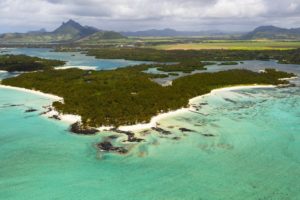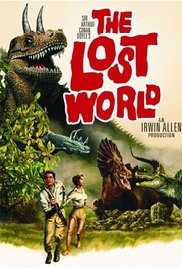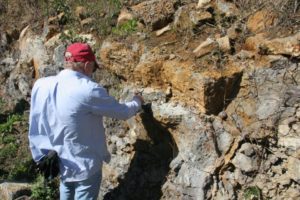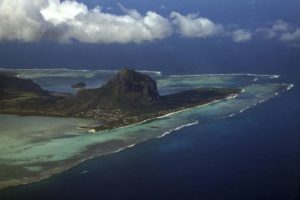New Lost Continent Discovered : A Well Thought Out Scream by James Riordan

All you Atlantis freaks out there, we got a new find! Recently, scientists uncovered evidence of an ancient “lost continent” under the Indian Ocean island nation of Mauritius, according to a new study. The continent, which geologists call “Mauritia,” formed part of present-day Madagascar and India. The rest of the continent probably sank beneath the sea 84 million years ago. “We are studying the break-up process of the continents, in order to understand the geological history of the planet,” said study lead author Lewis Ashwal of the University of the Witwatersrand in South Africa.
Wow. How many of you have ever heard of Lemuria or Moo? How about Professor Challenger’s Lost World? All lost continents. The last one is a fine old sci-fi movie based on an Arthus Conan Doyle novel of the same name. It starred Claude Rains as Professor George Edward Challenger — the short-tempered leader of the expedition, Michael Rennie as Lord John Roxton an experienced big-game hunter who joins the expedition (and you know you always need a big-game hunter in lost continent movies because there is always some BIG game. Unfortunately, extensive experience in shooting lions, tigers, elephants and rhinos doesn’t help much when you’re trying to bring down a dinosaur. The movie also featured Jill St. John at her fetching best, David Hedison as a journalist and Fernando Lamas as the always-necessary half crazy, jungle guide who is ready to betray the rest of the gang for a coconut or anything of equal or more value. It’s a hoot. Even more fun are the legends behind Lemuria and Moo, but I’ll leave it to you to explore them if you choose.
This newly found continent was likely part of the gigantic supercontinent called Gondwana by prehistoric researchers. Gondwana broke up to become Antarctica, Africa, Australia and South America. According to Wikipedia, there are two contrasting models for supercontinent evolution through geological time. The first model theorizes that at least two separate supercontinents existed comprising Vaalbara (from ~3600 to 2500 Ma) and Kenorland (from ~2700 to 2450 Ma). The Neoarchean supercontinent consisted of Superia and Sclavia. These parts of Neoarchean age broke off at ~2300 and 2090 Ma and portions of them later collided to form Nuna (Northern Europe North America) (~1750 Ma). Nuna continued to develop during the Mesoproterozoic, primarily by lateral accretion of juvenile arcs, and in ~1000 Ma Nuna collided with other land masses, forming Rodinia.[4] Between ~800 and 700 Ma Rodinia broke apart.[6] However, before completely breaking up, some fragments of Rodinia had already come together to form Gondwana (also known as Gondwanaland) by ~530 Ma. Pangaea formed by ~300 Ma through the collision of Gondwana, Laurentia, Baltica, and Siberia.
The second model (Protopangea-Paleopangea) is based on both palaeomagnetic and geological evidence and proposes that the contine ntal crust comprised a single supercontinent from ~2.7 Ga until break-up during the Ediacaran Period after ~0.6 Ga. The reconstruction[7] is derived from the observation that palaeomagnetic poles converge to quasi-static positions for long intervals between ~2.7–2.2, 1.5–1.25, and 0.75–0.6 Ga with only small peripheral modifications to the reconstruction.[8] During the intervening periods, the poles conform to a unified apparent polar wander path. Because this model shows that exceptional demands on the paleomagnetic data are satisfied by prolonged quasi-integrity, it must be regarded as superseding the first model proposing multiple diverse continents, although the first phase (Protopangea) essentially incorporates Vaalbara and Kenorland of the first model. The explanation for the prolonged duration of the Protopangea-Paleopangea supercontinent appears to be that Lid Tectonics (comparable to the tectonics operating on Mars and Venus) prevailed during Precambrian times. Plate Tectonics as seen on the contemporary Earth became dominant only during the latter part of geological times.[8]
ntal crust comprised a single supercontinent from ~2.7 Ga until break-up during the Ediacaran Period after ~0.6 Ga. The reconstruction[7] is derived from the observation that palaeomagnetic poles converge to quasi-static positions for long intervals between ~2.7–2.2, 1.5–1.25, and 0.75–0.6 Ga with only small peripheral modifications to the reconstruction.[8] During the intervening periods, the poles conform to a unified apparent polar wander path. Because this model shows that exceptional demands on the paleomagnetic data are satisfied by prolonged quasi-integrity, it must be regarded as superseding the first model proposing multiple diverse continents, although the first phase (Protopangea) essentially incorporates Vaalbara and Kenorland of the first model. The explanation for the prolonged duration of the Protopangea-Paleopangea supercontinent appears to be that Lid Tectonics (comparable to the tectonics operating on Mars and Venus) prevailed during Precambrian times. Plate Tectonics as seen on the contemporary Earth became dominant only during the latter part of geological times.[8]
The Phanerozoic supercontinent Pangaea began to break up 180 Ma and is still doing so today. Because Pangaea is the most recent of Earth’s supercontinents, it is the most well known and understood. Contributing to Pangaea’s popularity in the classroom is the fact that its reconstruction is almost as simple as fitting the present continents bordering the Atlantic-type oceans like puzzle pieces.[4]
So, after wading through that Wikipedia word jungle, I’m sure you’re ready to believe anything. By the way, none of these lost world studies mention dinosaurs, scantily clad Indians who, have never seen a person of another race before, are always instantly ready to sacrifice them to something that comes out of the smoky mists.
Anyway, they way this new lost continent was discovered was by studying the mineral zircon, which is found in rocks spewed up by lava during volcanic eruptions. Ashwal and his colleagues discovered remnants of this mineral that were much too old to belong on the island of Mauritius. “Earth is made up of two parts — continents, which are old, and oceans, which are ‘young,'” he said. On continents, rocks can be billions of years old, but nothing that old exists in the oceans, explained Ashwal.
Mauritius is only a few million years old, while some recently discovered zircon crystals on the island were estimated at 3 billion years old. “The fact that we have found zircons of this age proves that there are much older crustal materials under Mauritius that could only have originated from a continent,” says Ashwal.
The study said there are likely many pieces of various sizes of “undiscovered continent, collectively called Mauritia,” spread over the Indian Ocean. The study appeared in the peer-reviewed British journal Nature Communications.
And another thing — shouldn’t there be a bunch of diamonds that the native call “rock candy” or a solid gold city…or something?
___






No Comment